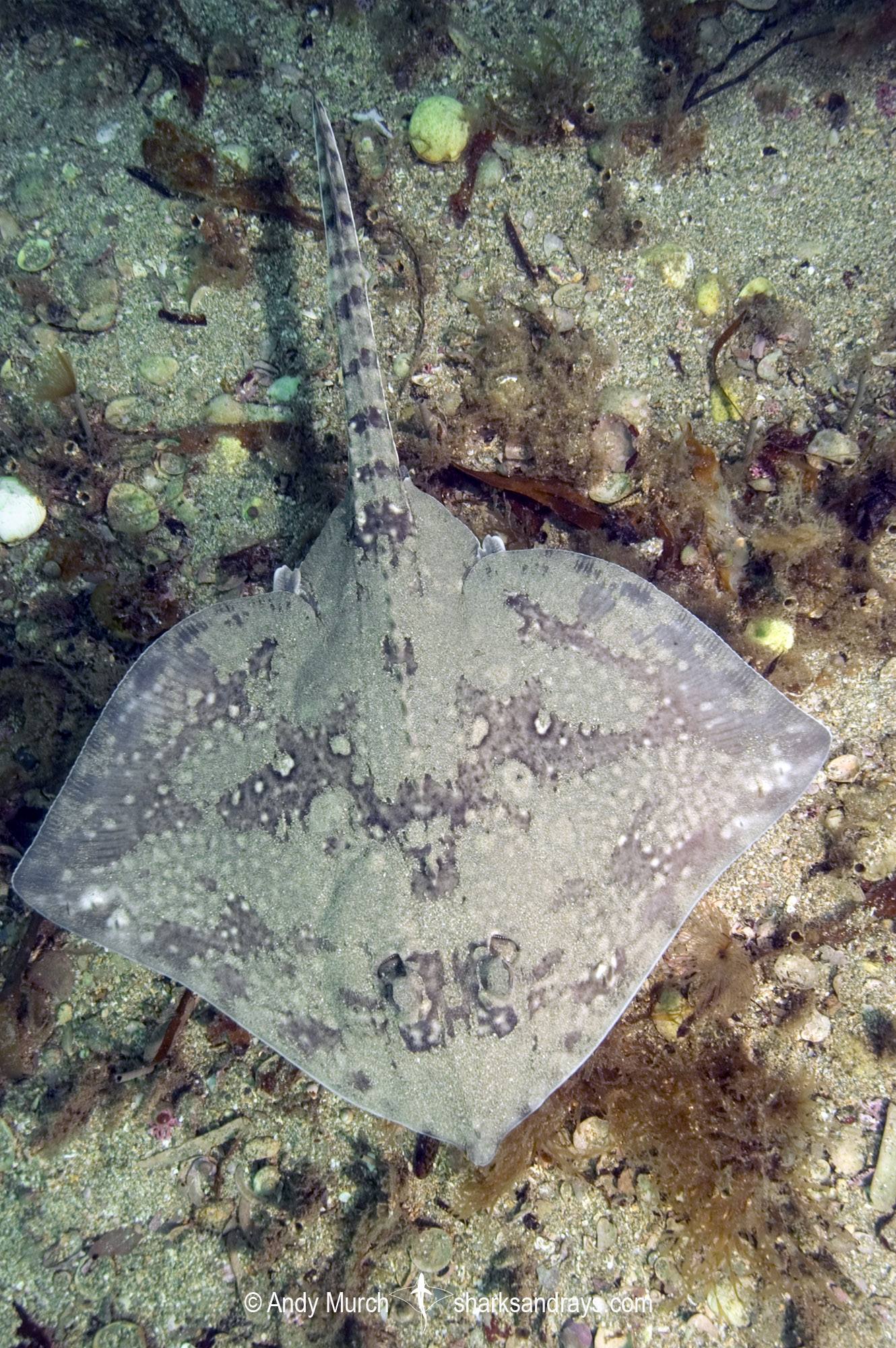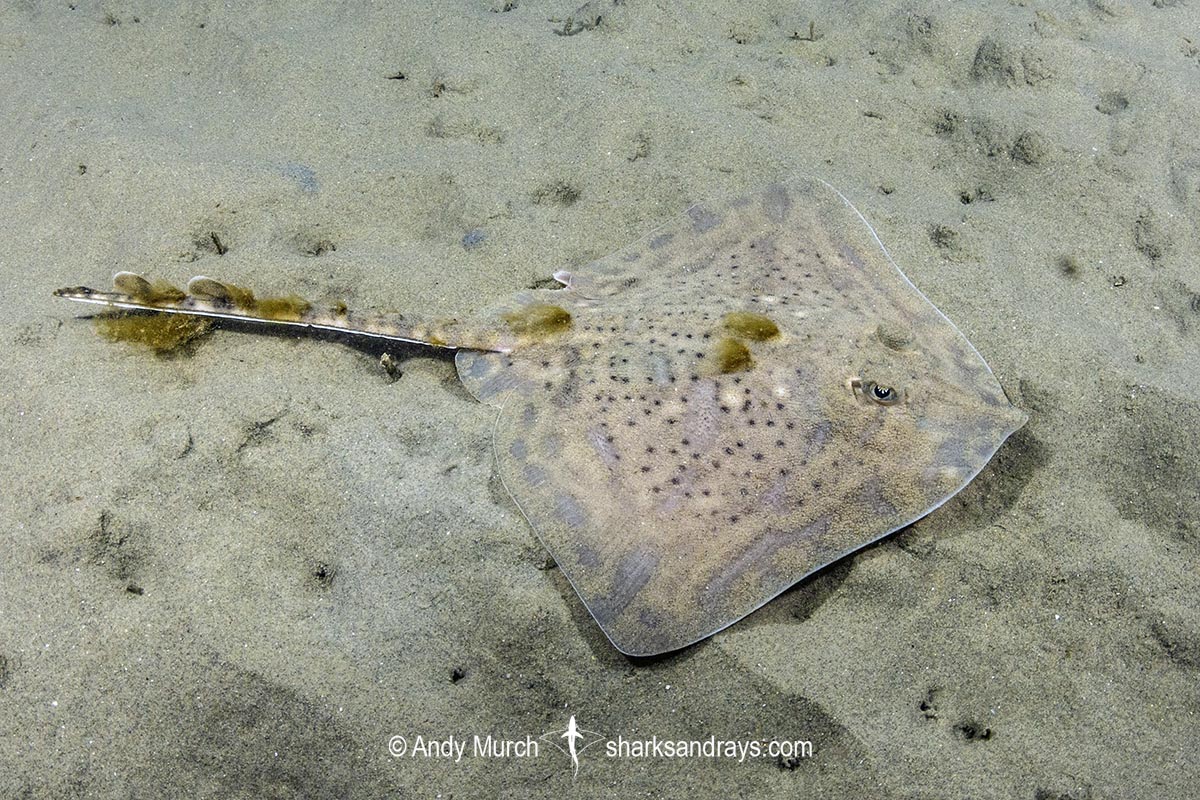Common names
Thornback Skate, Thornback Ray (UK).
Binomial
Raja clavata
Synonyms
Cephaleutherus maculatus, Hieroptera abredonensis, Malacoraja clavata, Raia aspera, Raia rhizacanthus, Raia rubus, Raja aspera, Raja bonaespeiensis, Raja capensis, Raja leiobatos, Raja pontica, Raja rubus
Identification
A medium-sized skate with a kite-shaped disc. Disc width ~1.3 x disc length. Snout moderately long, anterior angle obtuse or broadly rounded, with a small protruding tip. Eyes relatively large. Anterior margins of pectoral fins almost straight or weakly undulate. Pectoral apices angular. Disc covered in small prickly thorns in juveniles. Thorny tubercles present on dorsal and ventral disc in adult females. 30-50 thorns on midline from nape to first dorsal fin, midline thorns discontinuous in adult males. Pelvic fins relatively small, weakly notched. Anterior pelvic lobe much shorter than posterior lobe. Tail narrow and relatively long. Dorsal fins separated, with rounded margins. Up to 2 interdorsal thorns. Caudal fin small.
Colour
Dorsum grey or brownish-grey, with numerous small dark spots and scattered larger pale spots and blotches. Disc margin broadly variegated. Tail pale with irregular grey/brown saddles. Dorsal fins greyish brown with white posterior margins. Ventrum white, posterior ventral disc margin dusky.
Size
Maximum length 130cm. Egg case length 6-9cm. Length at hatching 10-13cm.

Conservation Status
NEAR THREATENED
Thornback Skate is a very important component of demersal fisheries in most European waters and is taken by trawl and gillnet, particularly as bycatch. There is or has been limited directed longlining and netting for the species. Landings of this species are not known, as landings of all rajids are combined in the records (ICES 1958-1987). Holden (1963) looked at the species composition of rajids landed by commercial trawlers at Milford Haven and Fleetwood, UK, during 1961 and 1962 and R. clavata accounted for 34.9% and 12.72% respectively. There is no evidence of severe population depletion, as has been documented for the Common Skate (Dipturus batis), although landings are considered to be in decline and a management strategy is required. Thornback Skates are also regularly caught by recreational anglers, although mortality from this source of fishing pressure will be of little impact for the population as a whole, particularly in areas where catch and release is practised.

Habitat
Temperate seas. Demersal sand, mud, gravel, and mixed substrates. Occurs inshore, and on the continental shelf and slope. Also found in kelp and in brackish estuaries. From 5-1020m.
Distribution
Eastern Atlantic, Mediterranean Sea, and southwest Indian Ocean. The thornback skate has a wide range from Iceland southward to South Africa and east as far as Mozambique and southern Madagascar and Reunion Island. It is present throughout much of the Mediterranean and into the western half of the Black Sea.
Reproduction
Oviparous. Up to 150 egg cases deposited per year. Females mature at 7-8yrs.
Diet
The thornback skate’s diet consists mainly of crustaceans and bony fishes.
Behavior
Thornback skates in the UK move into shallow coastal and estuarine areas to give birth, such as the Wash and Thames estuary.
Reaction to divers
Easy to approach. Remains motionless relying on camouflage unless harassed.
Diving logistics
The thornback skate is commonly encountered at many popular dive sites around the British Isles, and along the coast of Western Europe from Norway to Spain. This species is probably seen less in the Mediterranean and northwest Africa where higher surface temperatures likely force it deeper.
I have encountered this species a handful of times in shallow bays in southern England and once quite far up the Helford River in Cornwall. I have also seen thornback skates in Namsen Fjord in western Norway in 15m in October.
Images of adult thornback skates
Images of juvenile thornback skates
What’s new
View our full list of updates
Similar species
Biscuit Skate Similarly shaped and patterned but with a mostly plain tail with 4-5 dusky saddles.
Madeira Skate Similarly shaped and with a banded tail but distinguishable by more reticulated pattern and transverse bands on disc.













